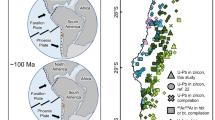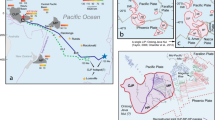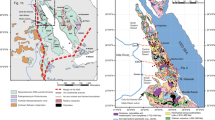Abstract
The formation of oceanic crust at mid-ocean ridges is a fundamental component of plate tectonics. A large fraction of the new crust is created when magmas in the lower crust cool to form gabbroic rocks. The duration of magmatism during formation of the new gabbroic crust is expected to vary with plate-spreading rate and has been constrained by dating gabbroic rocks at the slow-spreading Southwest Indian Ridge and Mid-Atlantic Ridge1,2,3,4. Here we present high-precision U–Pb dating of zircon minerals from gabbroic rocks formed at the fast-spreading East Pacific Rise and exposed at Hess Deep. We find that the zircons formed between 1.420 and 1.271 (±0.006–0.081) million years ago. Within individual samples, the zircon minerals exhibit a range in formation dates of up to 0.124 Myr, consistent with either protracted crystallization from a magma or assimilation into the magma of older zircons from adjacent rocks. The variability of zircon dates is comparable to that measured at the slow-spreading Mid-Atlantic Ridge3. We conclude that the timescales of magmatic processes in the lower crust may be similar at slow- and fast-spreading ridges, implying that the duration of crust formation at mid-ocean ridges is not only controlled by spreading rate.
This is a preview of subscription content, access via your institution
Access options
Subscribe to this journal
Receive 12 print issues and online access
$259.00 per year
only $21.58 per issue
Buy this article
- Purchase on Springer Link
- Instant access to full article PDF
Prices may be subject to local taxes which are calculated during checkout



Similar content being viewed by others
References
Baines, A. G. et al. SHRIMP Pb/U zircon ages constrain gabbroic crustal accretion at Atlantis Bank on the ultraslow-spreading Southwest Indian Ridge. Earth Planet. Sci. Lett. 287, 540–550 (2009).
Grimes, C. B., John, B. E., Cheadle, M. J. & Wooden, J. L. Protracted construction of gabbroic crust at a slow spreading ridge: Constraints from 206Pb/238U zircon ages from Atlantis Massif and IODP Hole U1309D (30°N, MAR). Geochem. Geophys. Geosyst. 9, Q08012 (2008).
Lissenberg, C. J., Rioux, M., Shimizu, N., Bowring, S. A. & Mevel, C. Zircon dating of oceanic crustal accretion. Science 323, 1048–1050 (2009).
Schwartz, J. J. et al. Dating the growth of oceanic crust at a slow-spreading ridge. Science 310, 654–657 (2005).
Detrick, R. S. et al. Multi-channel seismic imaging of a crustal magma chamber along the East Pacific Rise. Nature 326, 35–41 (1987).
Hussenoeder, S. A., Collins, J. A., Kent, G. M., Detrick, R. S. & TERA Group, Seismic analysis of the axial magma chamber reflector along the southern East Pacific Rise from conventional reflection profiling. J. Geophys. Res. 101, 22087–22105 (1996).
Hooft, E. E. E., Detrick, R. S. & Kent, G. M. Seismic structure and indicators of magma budget along the Southern East Pacific Rise. J. Geophys. Res. 102, 27319–27340 (1997).
Dunn, R. A., Toomey, D. R. & Solomon, S. C. Three-dimensional seismic structure and physical properties of the crust and shallow mantle beneath the East Pacific Rise at 9°30′N. J. Geophys. Res. 105, 23537–23555 (2000).
Crawford, W. C. & Webb, S. C. Variations in the distribution of magma in the lower crust and at the Moho beneath the East Pacific Rise at 9°–10° N. Earth Planet. Sci. Lett. 203, 117–130 (2002).
Hey, R. N., Deffeyes, K. S., Johnson, G. L. & Lowrie, A. The Galapagos Triple Junction and plate motions in the East Pacific. Nature 237, 20–22 (1972).
Lonsdale, P. Structural pattern of the Galapagos Microplate and evolution of the Galapagos Triple Junctions. J. Geophys. Res. 93, 13551–13574 (1988).
Lonsdale, P. Regional shape and tectonics of the equatorial East Pacific Rise. Mar. Geophys. Res. 3, 295–315 (1977).
Karson, J. A. et al. Structure of uppermost fast-spread oceanic crust exposed at the Hess Deep Rift: Implications for subaxial processes at the East Pacific Rise. Geochem. Geophys. Geosyst. 3, 2001GC000155 (2002).
Francheteau, J. et al. 1 Myr East Pacific Rise oceanic crust and uppermost mantle exposed by rifting in Hess Deep (equatorial Pacific Ocean). Earth Planet. Sci. Lett. 101, 281–295 (1990).
MacLeod, C. J., Célérier, B., Früh-Green, G. L. & Manning, C. E. in Proc. Ocean Drilling Program, Scientific Results, Vol. 147 (eds Mével, C., Gillis, K. M., Allan, J. F. & Meyer, P. S.) (Ocean Drilling Program, 1996).
MacLeod, C. J., Teagle, D. A. H., Gillis, K. M. & Shillington, D. J. RRS James Cook Cruise JC21 Scientific Party, Morphotectonics of Hess Deep: Preliminary results of RRS James Cook Cruise JC21. AGU (Fall Meeting), V43I-08 (2008).
Lissenberg, C. J., MacLeod, C. J., Howard, K. A. & Godard, M. Pervasive reactive melt migration through the lower oceanic crust. AGU (Fall Meeting), V13F-02 (2011).
Wendt, I. & Carl, C. The statistical distribution of the mean squared weighted deviation. Chem. Geol. 86, 275–285 (1991).
Vermeesch, P. HelioPlot, and the treatment of overdispersed (U–Th–Sm)/He data. Chem. Geol. 271, 108–111 (2010).
MacLeod, C. J. & Yaouancq, G. A fossil melt lens in the Oman ophiolite: Implications for magma chamber processes at fast-spreading ridges. Earth Planet. Sci. Lett. 176, 357–373 (2000).
DeMets, C., Gordon, R. G. & Argus, D. F. Geologically current plate motions. Geophys. J. Int. 181, 1–80 (2010).
Turner, S., Beier, C., Niu, Y. & Cook, C. U–Th–Ra disequilibria and the extent of off-axis volcanism across the East Pacific Rise at 9°30′ N,10°30′ N, and 11°20′ N. Geochem. Geophys. Geosyst. 12, Q0AC12 (2011).
Durant, D. T. & Toomey, D. R. Evidence and implications of crustal magmatism on the flanks of the East Pacific Rise. Earth Planet. Sci. Lett. 287, 130–136 (2009).
Kent, G. M. et al. Evidence from three-dimensional seismic reflectivity images for enhanced melt supply beneath mid-ocean-ridge discontinuities. Nature 406, 614–618 (2000).
Cannat, M. How thick is the magmatic crust at slow spreading oceanic ridges? J. Geophys. Res. 101, 2847–2857 (1996).
Mattinson, J. M. Zircon U/Pb chemical abrasion (CA-TIMS) method: Combined annealing and multi-step partial dissolution analysis for improved precision and accuracy of zircon ages. Chem. Geol. 220, 47–66 (2005).
Bowring, J. F., McLean, N. M. & Bowring, S. A. Engineering cyber infrastructure for U–Pb geochronology: Tripoli and U-Pb_Redux. Geochem. Geophys. Geosyst. 12, Q0AA19 (2011).
McLean, N. M., Bowring, J. F. & Bowring, S. A. An algorithm for U–Pb isotope dilution data reduction and uncertainty propagation. Geochem. Geophys. Geosyst. 12, Q0AA18 (2011).
Schouten, H., Smith, D. K., Montési, L. G. J., Zhu, W. & Klein, E. M. Cracking of lithosphere north of the Galapagos triple junction. Geology 36, 339–342 (2008).
Smith, D. K., Schouten, H., Zhu, W.-l., Montési, L. G. J. & Cann, J. R. Distributed deformation ahead of the Cocos–Nazca Rift at the Galapagos triple junction. Geochem. Geophys. Geosyst. 12, Q11003 (2011).
Acknowledgements
This research was partially funded by National Science Foundation grant OCE-0727914 (S.A.B.), a Cardiff University International Collaboration Award (C.J.L.) and Natural Environment Research Council grant NE/C509023/1 (C.J.M.). We thank L. Koons for separating the Hess Deep zircons, O. Jagoutz and F. Frey for useful discussions of Th and U partitioning in zircon, and D. Wilson for reading and commenting on a draft of the manuscript. We thank J. Schwartz and G. Baines for detailed and useful reviews.
Author information
Authors and Affiliations
Contributions
M.R. performed zircon geochronology and wrote the paper. C.J.L. collected the samples, performed trace element analyses and generated cathodoluminescence and backscattered electron images. N.M.M. provided statistical expertise. S.A.B. assisted with zircon geochronology. C.J.M. collected the samples and drafted the maps. E.H. generated Y and Hf maps and cathodoluminescence and backscattered electron images. N.S. performed trace element analyses.
Corresponding author
Ethics declarations
Competing interests
The authors declare no competing financial interests.
Supplementary information
Supplementary Information
Supplementary Information (PDF 2903 kb)
Rights and permissions
About this article
Cite this article
Rioux, M., Johan Lissenberg, C., McLean, N. et al. Protracted timescales of lower crustal growth at the fast-spreading East Pacific Rise. Nature Geosci 5, 275–278 (2012). https://doi.org/10.1038/ngeo1378
Received:
Accepted:
Published:
Issue Date:
DOI: https://doi.org/10.1038/ngeo1378
This article is cited by
-
Formation of lower fast-spread oceanic crust: a structural and geochemical study of troctolites in the Hess Deep Rift (East Pacific Rise)
Progress in Earth and Planetary Science (2023)
-
Volcanic evolution of an ultraslow-spreading ridge
Nature Communications (2023)
-
Zircon petrochronology in large igneous provinces reveals upper crustal contamination processes: new U–Pb ages, Hf and O isotopes, and trace elements from the Central Atlantic magmatic province (CAMP)
Contributions to Mineralogy and Petrology (2021)
-
No significant boron in the hydrated mantle of most subducting slabs
Nature Communications (2018)
-
Hydrothermal spinel, corundum and diaspore in lower oceanic crustal troctolites from the Hess Deep Rift
Contributions to Mineralogy and Petrology (2016)



